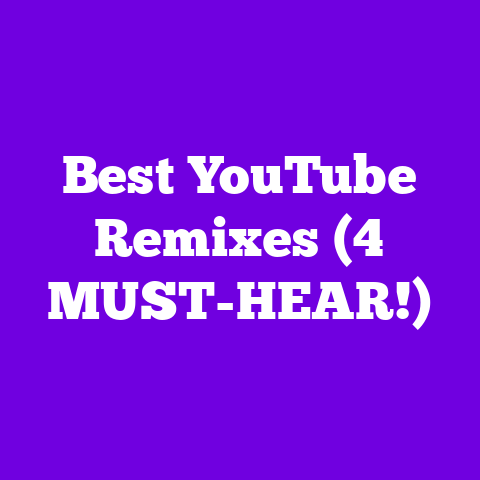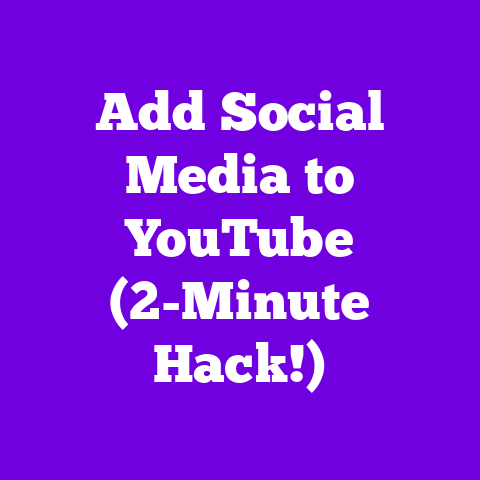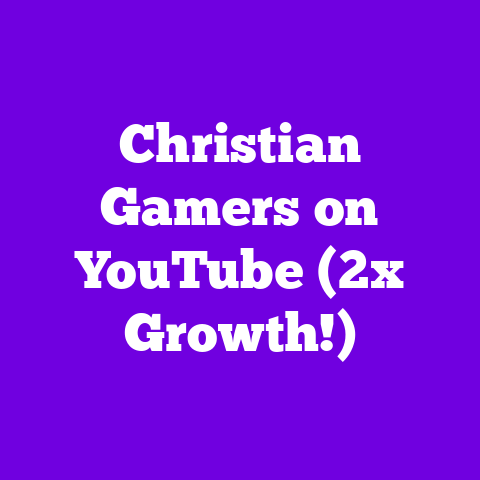Create Youtube Page For Business (1-Day Project!)
Let me tell you a story.
It was back in 2018, and I was running a small online store selling handcrafted leather goods.
I’d tried everything – Facebook ads, Instagram posts, even that weird Pinterest phase.
Nothing seemed to stick.
Sales were sluggish, and I was starting to feel like I was shouting into the void.
Then, almost by accident, I uploaded a short video to YouTube showcasing how I made a wallet.
The response was insane.
People were commenting, asking questions, and, most importantly, buying.
That’s when it hit me: YouTube wasn’t just a place for cat videos and music; it was a powerhouse for business.
That initial spark ignited a passion in me, and I’ve been helping businesses leverage the power of YouTube ever since.
That experience led me to dive headfirst into creating YouTube pages for businesses, both my own and those of my clients.
I learned the ins and outs, the tricks and the traps.
And I discovered that the initial setup, the foundation, could be laid in a single day.
In 2025, the digital landscape is a roaring river of content.
Standing still means drowning.
That’s why I created this guide – a practical, hands-on blueprint for setting up a YouTube page for your business in just one day.
We’re not talking about perfection; we’re talking about action.
Let’s get you seen.
Understanding YouTube as a Business Tool
YouTube is no longer just a social media platform; it’s a search engine, a community hub, and a powerful marketing tool all rolled into one.
In 2025, ignoring YouTube is like ignoring a massive chunk of your potential customer base.
Think about it: where do people go to learn how to fix a leaky faucet, compare the latest smartphones, or find reviews of local restaurants?
YouTube.
The platform has evolved dramatically.
Remember those grainy, low-quality videos from the early days?
Now, we’re talking about professional-grade content, live streams, and interactive experiences.
This evolution has made YouTube a prime destination for businesses looking to connect with their audience on a deeper level.
Let’s look at some stats.
According to Statista, YouTube has over 2.5 billion active users worldwide.
That’s a staggering number!
And these users aren’t just passively watching; they’re actively engaging.
They’re commenting, liking, sharing, and subscribing.
This engagement translates into brand awareness, lead generation, and ultimately, sales.
Furthermore, YouTube provides incredible SEO benefits.
Google, which owns YouTube, prioritizes video content in search results.
By optimizing your videos with relevant keywords and compelling descriptions, you can significantly improve your search engine ranking.
This means more visibility, more traffic, and more potential customers finding your business.
Why should your business consider YouTube as a primary marketing tool?
- Massive Reach: Access billions of potential customers globally.
- Engaging Content Format: Video is inherently more engaging than text or images.
- Improved SEO: Boost your search engine ranking and drive traffic to your website.
- Brand Building: Showcase your brand personality and build trust with your audience.
- Measurable Results: Track your performance with detailed analytics and optimize your strategy.
Setting Up Your YouTube Page
Alright, let’s get down to the nitty-gritty.
This is where we roll up our sleeves and build your YouTube page from scratch.
Remember, we’re aiming for a one-day setup, so let’s stay focused and efficient.
Step 1: Creating a Google Account
If you already have a Google account, you can skip this step.
But if not, it’s quick and easy.
Head over to accounts.google.com and click “Create account.”
- Fill in your first and last name.
- Choose a username – this will be your Gmail address.
- Create a strong password (use a combination of upper and lowercase letters, numbers, and symbols).
- Enter your birthday and gender.
- Verify your phone number.
Choosing a business-focused email and username is crucial. Avoid using personal nicknames or unprofessional language.
Ideally, your username should reflect your brand name or a relevant keyword.
For example, if you run a coffee shop called “The Daily Grind,” your username could be “TheDailyGrindCoffee.” This helps with brand recognition and searchability.
Step 2: Setting Up Your YouTube Channel
Now that you have a Google account, let’s create your YouTube channel.
- Go to YouTube.com and sign in with your Google account.
- Click on your profile icon in the top right corner and select “Create a channel.”
- You’ll be presented with two options: “Use your name” or “Use a custom name.”
This is where you need to choose between a personal and a business channel. While using your name might seem simpler, a business channel is essential for several reasons:
- Branding: It allows you to create a distinct brand identity separate from your personal profile.
- Analytics: Business channels provide more detailed analytics and insights into your audience and video performance.
- Multiple Users: You can grant access to multiple users to manage your channel, which is crucial for team collaboration.
Choose “Use a custom name” and enter your business name.
Click “Create.” Congratulations!
You now have a YouTube channel for your business.
Step 3: Branding Your Channel
This is where you make your channel visually appealing and representative of your brand.
Branding is about creating a consistent and memorable experience for your viewers.
- Channel Name: As we discussed earlier, your channel name should reflect your brand.
If your business name is already taken, consider adding a relevant keyword or descriptor. - Channel Art: This is the large banner image that appears at the top of your channel.
It’s prime real estate, so use it wisely.
Your channel art should be visually appealing, professional-looking, and relevant to your brand.
Canva.com is an excellent tool for creating channel art, even if you don’t have any design experience.
Dimensions should be 2560 x 1440 pixels. - Logo: Your logo is the small image that appears next to your channel name on your channel page and in search results.
It should be recognizable and representative of your brand.
The ideal size is 800 x 800 pixels. - Channel Description: This is a short paragraph that describes your channel and what viewers can expect to find there.
Use relevant keywords to improve searchability.
Be concise and engaging.
Tell people what problems you can solve for them. - Channel Trailer: This is a short video (ideally under 60 seconds) that introduces your channel to new viewers.
It should highlight your best content, showcase your brand personality, and encourage viewers to subscribe.
Creating a compelling channel trailer is crucial. It’s your chance to make a first impression and convince viewers to stick around.
Here are some tips:
- Start with a Hook: Grab viewers’ attention in the first few seconds.
- Highlight Your Best Content: Showcase your most popular or engaging videos.
- Showcase Your Brand Personality: Let your viewers know what makes your channel unique.
- Call to Action: Encourage viewers to subscribe, watch more videos, and visit your website.
Professional appearance is non-negotiable. In 2025, viewers expect high-quality content and a polished presentation.
Invest in good lighting, sound, and editing.
Even if you’re just starting out, you can create professional-looking videos with affordable equipment and free editing software.
Content Strategy for Your YouTube Channel
Now that your channel is set up, it’s time to think about what kind of content you’re going to create.
A solid content strategy is the backbone of any successful YouTube channel.
Identifying Your Target Audience
Before you start brainstorming content ideas, you need to know who you’re creating content for.
Who is your ideal viewer?
What are their interests, needs, and pain points?
- Research Your Existing Customers: Analyze your customer data to identify trends and patterns.
- Use YouTube Analytics: Once you have some videos uploaded, you can use YouTube Analytics to learn more about your audience’s demographics, interests, and viewing habits.
- Conduct Surveys and Polls: Ask your audience directly what they want to see.
- Analyze Your Competitors: See what kind of content your competitors are creating and what their audience is responding to.
Understanding your target audience is crucial for creating content that resonates with them.
Don’t just create content that you think is interesting; create content that your audience wants to watch.
Content Types and Ideas
The possibilities for content types are endless.
Here are some ideas to get you started:
- Tutorials: Show your audience how to do something.
- Product Reviews: Review products related to your industry.
- Behind-the-Scenes: Give your audience a glimpse into your business.
- Customer Testimonials: Share positive feedback from your customers.
- Interviews: Interview experts in your field.
- Live Streams: Interact with your audience in real-time.
- Vlogs: Share your thoughts and experiences.
Let’s brainstorm some content ideas based on different business niches:
- Restaurant: Recipe tutorials, restaurant tours, chef interviews, customer testimonials.
- Software Company: Software demos, tutorials, case studies, industry insights.
- Clothing Boutique: Style guides, outfit ideas, behind-the-scenes look at the design process, customer styling sessions.
- Real Estate Agent: Property tours, neighborhood guides, tips for buying and selling homes, interviews with local experts.
Consistency is key. A consistent posting schedule is essential for keeping your audience engaged and growing your channel.
Create a content calendar and stick to it.
Aim to post at least once a week, but ideally more often.
Use tools like Trello or Asana to manage your content planning.
Optimizing Videos for Success
Creating great content is only half the battle.
You also need to optimize your videos so that people can find them.
This is where video SEO comes in.
- Titles: Your video title should be clear, concise, and keyword-rich.
Include relevant keywords that your target audience is likely to search for.
Keep your titles under 60 characters. - Descriptions: Your video description should provide more detail about your video and include relevant keywords.
The first few sentences of your description are the most important, as they will be displayed in search results.
Aim for at least 200 words. - Tags: Tags are keywords that you add to your video to help YouTube understand what it’s about.
Use a mix of broad and specific tags.
Use tools like VidIQ or TubeBuddy to find relevant tags. - Thumbnails: Your video thumbnail is the image that viewers see before they click on your video.
It should be eye-catching, visually appealing, and representative of your video content.
Use bright colors, clear text, and high-quality images.
The ideal size is 1280 x 720 pixels.
Engaging with viewers is crucial for building a community. Respond to comments, ask questions, and run contests.
Use community posts to share updates, ask for feedback, and promote your other videos.
Analytics are your best friend. YouTube Analytics provides valuable insights into your audience’s behavior and your video performance.
Use analytics to track your views, watch time, audience retention, and engagement.
Identify what’s working and what’s not, and adjust your strategy accordingly.
Promoting Your YouTube Channel
You’ve created amazing content and optimized your videos, but now you need to get the word out.
- Social Media: Share your videos on all your social media platforms.
- Website/Blog: Embed your videos on your website or blog.
- Email Marketing: Include links to your videos in your email newsletters.
- Collaborations: Collaborate with other YouTubers or influencers in your niche.
- Cross-Promotion: Promote your other videos in your end screens and cards.
Collaborations can be a game-changer. Partnering with other YouTubers or influencers can expose your channel to a whole new audience.
Look for creators who share your target audience and create content that complements yours.
Cross-promoting videos on your website or blog is a must. This not only drives traffic to your YouTube channel but also improves your website’s SEO.
Conclusion
Congratulations!
You’ve successfully created a YouTube page for your business in just one day.
Remember that initial spark I felt when I first realized the power of YouTube?
I hope you’re feeling that same excitement now.
I encourage you to take action and start your own YouTube journey.
Don’t be afraid to experiment, make mistakes, and learn from your experiences.
The beauty of YouTube is that it’s constantly evolving, so there’s always something new to learn.
While the setup can be done in a day, the real work lies in consistently producing valuable content that connects with your audience.
It’s about building relationships, providing value, and becoming a trusted resource in your industry.
So, go out there and create something amazing. Your audience is waiting.





